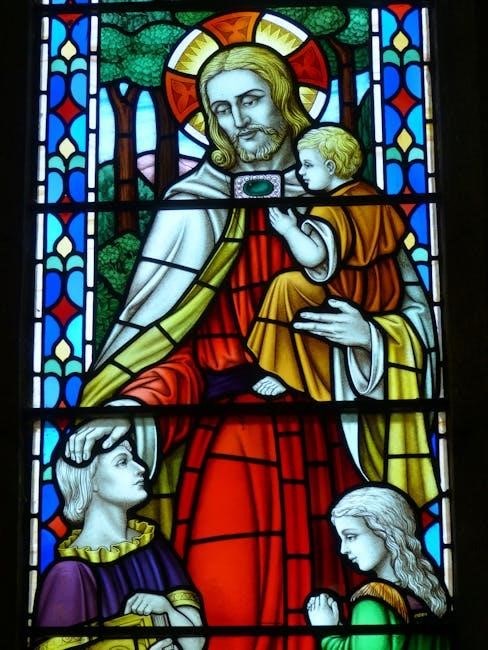Biblical genealogy traces the lineage from Adam to Jesus‚ highlighting the divine plan and fulfillment of prophecies. It connects humanity’s origins to the Messiah‚ emphasizing covenant promises and redemption.
1.1 The Importance of Genealogy in the Bible
Biblical genealogy is crucial for understanding the historical and theological framework of Scripture. It establishes the continuity of God’s covenant promises‚ linking key figures like Adam‚ Noah‚ Abraham‚ and David to Jesus. Genealogies validate the legitimacy of leaders and Messiah‚ showing how Jesus fulfills Old Testament prophecies. They also illustrate God’s plan across generations‚ emphasizing His faithfulness. By tracing lineage‚ the Bible connects believers to a spiritual family‚ highlighting unity and purpose. This ancestral record underscores the universal appeal of Jesus’ mission‚ bridging humanity’s past with its redemptive future through Him.
1.2 The Connection Between Adam and Jesus
The connection between Adam and Jesus is a theological cornerstone‚ tracing humanity’s origin to its redemption. Adam‚ the first man‚ represents the fallen nature of humanity‚ while Jesus‚ as the “second Adam‚” embodies redemption. Biblical genealogy bridges this gap‚ showing Jesus as the fulfillment of God’s plan. From Adam through Noah‚ Abraham‚ David‚ and ultimately to Jesus‚ the lineage underscores His divine mission. This connection highlights Jesus’ role as the Messiah‚ emphasizing His universal appeal and humanity’s spiritual renewal through Him. The genealogy from Adam to Jesus illustrates God’s covenant faithfulness and redemptive purpose across generations.
The Genealogy of Jesus in the Gospels
The Gospels of Matthew and Luke provide detailed genealogies of Jesus‚ tracing His lineage from Adam to Joseph and Mary‚ emphasizing His divine and human connection.
2.1 Matthew’s Account of Jesus’ Genealogy
Matthew’s genealogy focuses on Jesus’ legal lineage through Joseph‚ tracing from Abraham to Jesus. It is structured in three sets of 14 generations‚ emphasizing Jesus as the Messiah. Key figures include Abraham‚ David‚ and Ruth‚ showcasing God’s covenant promises. The genealogy highlights Jesus’ royal and messianic heritage‚ fulfilling Old Testament prophecies. While Mary is mentioned‚ the emphasis remains on Joseph’s line‚ underscoring Jesus’ legal right to David’s throne. This account is tailored for a Jewish audience‚ demonstrating Jesus’ legitimacy as the Messiah and the culmination of Israel’s history.
2.2 Luke’s Account of Jesus’ Genealogy
Luke’s genealogy traces Jesus’ lineage through Mary‚ emphasizing His divine connection to Adam and humanity. It begins with Jesus and extends backward to Adam‚ highlighting universal themes. Unlike Matthew‚ Luke’s account includes Heli as Joseph’s father‚ linking Jesus to the broader human family. This genealogy underscores Jesus’ role as the “second Adam‚” connecting His mission to all mankind. Luke’s approach appeals to a Gentile audience‚ showcasing Jesus as the Savior for all people. The genealogy spans 77 generations‚ reflecting a comprehensive view of human history and Jesus’ place within it as the ultimate fulfillment of God’s plan.

2.3 Differences Between Matthew and Luke’s Genealogies
Matthew and Luke present distinct genealogies of Jesus‚ reflecting different purposes. Matthew’s account begins with Abraham and ends with Joseph‚ focusing on Jesus’ legal lineage through Solomon‚ emphasizing His royal heritage. Luke’s genealogy starts with Jesus and traces back to Adam‚ highlighting His connection to humanity. Luke includes Heli as Joseph’s father‚ suggesting a physical lineage through Mary. Matthew skips some generations‚ while Luke provides a more comprehensive list. These differences underscore Matthew’s emphasis on Jesus as the Messiah for Israel and Luke’s broader focus on Jesus as the Savior for all humanity‚ aligning with their gospel themes.

Key Figures in the Genealogy from Adam to Jesus
The genealogy from Adam to Jesus includes pivotal figures like Noah‚ Abraham‚ Isaac‚ Jacob‚ and King David‚ each playing a crucial role in God’s covenant and redemptive plan.
3.1 Adam and the Early Descendants
Adam‚ the first man created in God’s image‚ is the root of biblical genealogy. His descendants‚ including Cain‚ Abel‚ and Seth‚ form the early lineage. Seth’s line is emphasized‚ leading through Enosh to Enoch‚ who was raptured‚ and Methuselah‚ the oldest man recorded. This lineage highlights humanity’s divine origin and the early stages of God’s redemptive plan‚ setting the stage for the Messiah’s arrival through Jesus.
3.2 Noah and the Post-Flood Genealogy
Noah is a pivotal figure in biblical genealogy‚ as his lineage survives the flood and repopulates the earth. His sons‚ Shem‚ Ham‚ and Japheth‚ become the ancestors of post-flood humanity. The genealogy emphasizes Shem’s line‚ leading to Eber and eventually Abraham‚ the father of nations. This post-flood lineage is crucial‚ as it connects Noah to the patriarchs and ultimately to Jesus‚ fulfilling God’s covenant promises. The post-flood genealogy underscores God’s plan of redemption and the continuity of His covenant with humanity‚ bridging the gap between the early descendants and the Messiah.
3.3 Abraham‚ Isaac‚ and Jacob

Abraham‚ the father of faith‚ is central to the genealogy‚ as God’s covenant with him establishes the lineage leading to Jesus. His son Isaac‚ the child of promise‚ continues this sacred line. Jacob‚ later named Israel‚ becomes the ancestor of the twelve tribes of Israel. Their stories highlight faith‚ obedience‚ and divine promises. Abraham’s trust in God‚ Isaac’s willingness to be sacrificed‚ and Jacob’s transformation exemplify spiritual growth. Their lives are pivotal in tracing the Messiah’s lineage‚ showing how God’s plan unfolds through their descendants‚ ultimately leading to Jesus‚ the fulfillment of all promises.
3.4 King David and the Royal Lineage
King David is a pivotal figure in the genealogy of Jesus‚ as his reign established the royal lineage through which the Messiah would come. David‚ a man after God’s heart‚ was promised an eternal throne‚ fulfilled in Jesus. His descendants‚ including Solomon‚ continued the royal line‚ despite the kingdom’s division. The genealogy highlights how Jesus‚ as the legal heir through Joseph‚ inherits the right to David’s throne. This lineage underscores God’s covenant faithfulness and the fulfillment of messianic prophecies‚ linking Israel’s history to the universal salvation offered through Jesus‚ the ultimate King of kings.

Historical Events in the Genealogy
Biblical genealogy traces pivotal events from creation to the Messiah‚ including the fall‚ flood‚ and patriarchs‚ revealing God’s plan through human history and lineage.
4.1 The Creation and the Fall of Man
The biblical account begins with the creation of Adam and Eve‚ the first humans‚ made in God’s image. Their disobedience in the Garden of Eden led to the fall‚ introducing sin and separation from God. This event marked the start of humanity’s need for redemption‚ setting the stage for the genealogy that would ultimately lead to Jesus‚ the Messiah. The creation and fall are foundational to understanding the biblical narrative‚ as they establish the context for God’s plan of salvation through the lineage of Adam to Jesus.
4.2 The Flood and Noah’s Covenant
The Flood‚ a divine judgment on humanity’s wickedness‚ reset the earth‚ saving only Noah‚ his family‚ and animals. Noah’s faith and obedience led to a covenant with God‚ symbolized by the rainbow‚ promising never to destroy the earth with a flood again. This event is crucial in the genealogy‚ as it bridges the pre-flood and post-flood worlds. Noah’s descendants‚ including Shem‚ Ham‚ and Japheth‚ repopulated the earth‚ continuing the lineage that would eventually lead to Abraham and‚ ultimately‚ Jesus. The Flood underscores God’s mercy and sets the stage for future covenant promises central to the biblical narrative.
4.3 The Patriarchs and the Promise of the Messiah
The patriarchs—Abraham‚ Isaac‚ and Jacob—played pivotal roles in the genealogy leading to Jesus. God established covenants with them‚ promising land‚ descendants‚ and blessings. Abraham‚ as the father of faith‚ received the promise of a Messiah through his lineage. Isaac and Jacob continued this legacy‚ with Jacob’s twelve sons forming the tribes of Israel. Their stories of faith‚ obedience‚ and divine intervention highlight God’s plan to redeem humanity. These patriarchs exemplify trust in God’s promises‚ setting the stage for Jesus’ arrival as the ultimate fulfillment of these covenants‚ bringing salvation to all people.
4.4 The Kingdom of Israel and the Divided Monarchy
The kingdom of Israel‚ established under King David‚ later divided into two monarchies: Israel (north) and Judah (south). This division significantly impacted the genealogy leading to Jesus. The northern kingdom’s eventual fall and the southern kingdom’s continued lineage through David emphasized God’s covenant faithfulness. Prophets like Isaiah and Jeremiah highlighted the importance of Judah’s royal line‚ from which Jesus descended. This period underscores the theological significance of Israel’s history‚ as the divided monarchy set the stage for the Messiah’s arrival‚ fulfilling prophecies and uniting God’s people under one King.

Theological Significance of the Genealogy
The genealogy from Adam to Jesus reveals God’s plan of redemption‚ showing Jesus as the fulfillment of Old Testament prophecies. It connects humanity’s origins to the Messiah‚ emphasizing covenant promises and universal salvation through Christ.
5.1 Jesus as the Fulfillment of Old Testament Prophecies
The genealogy from Adam to Jesus underscores Jesus’ role as the fulfillment of Old Testament prophecies. It traces the lineage through key figures like Abraham‚ Isaac‚ Jacob‚ and David‚ highlighting God’s covenant promises. Jesus’ birth and lineage align with prophecies about the Messiah‚ such as the seed of the woman (Genesis 3:15) and the Davidic covenant (2 Samuel 7:12-16). Matthew and Luke’s genealogies emphasize legal and physical lineage‚ confirming Jesus as the rightful heir to David’s throne. This lineage proves Jesus’ identity as the Messiah‚ connecting humanity’s origins to God’s redemptive plan‚ making Him the Savior for all mankind.
5.2 The Legal and Physical Lineage of Jesus
Jesus’ genealogy reveals both His legal and physical lineage‚ ensuring His rightful place in Israel’s history. Matthew’s account focuses on the legal lineage through Joseph‚ establishing Jesus’ claim to David’s throne. Luke’s genealogy‚ tracing through Mary‚ emphasizes Jesus’ physical descent from Adam‚ highlighting His humanity. Together‚ these lineages confirm Jesus’ dual identity as the legal heir of David and the physical descendant of Adam‚ uniting humanity’s origins with God’s redemptive plan. This duality underscores His role as both the Messiah of Israel and the Savior of all mankind‚ fulfilling Old Testament promises and universalizing His mission.
5.3 The Universal Appeal of Jesus’ Genealogy
Jesus’ genealogy‚ tracing from Adam to Jesus‚ emphasizes His universal relevance. Luke’s account connects Jesus to humanity’s first father‚ Adam‚ symbolizing His role as the Savior for all people. This lineage transcends Jewish heritage‚ making Jesus accessible to every culture and generation. The genealogy highlights God’s plan to redeem all humanity‚ bridging the gap between the Old Testament promises and the global mission of Christianity. Resources like PDF charts and timelines further illustrate this universal appeal‚ helping believers and seekers understand Jesus’ role as the unifying figure for mankind‚ uniting diverse backgrounds under one spiritual family.

Resources for Studying the Genealogy
Comprehensive PDF guides‚ charts‚ and timelines provide detailed lineage from Adam to Jesus‚ offering visual organization and easy tracing of generations for deeper biblical study and understanding.
6.1 Bible Charts and Timelines
Bible charts and timelines are essential tools for visualizing the genealogy from Adam to Jesus. These resources organize generations chronologically‚ making it easier to trace lineage and understand historical events. Many charts are color-coded to distinguish tribes and family lines‚ while timelines align biblical events with key figures. PDF versions‚ such as those from UsefulCharts and BibleTimeline.net‚ offer zoom and search features for detailed study. These visual aids are invaluable for educators‚ students‚ and enthusiasts‚ providing a clear overview of the biblical narrative and its fulfillment in Jesus. They are often paired with study guides for deeper exploration.
6.2 PDF Guides and Study Materials
PDF guides and study materials provide in-depth exploration of the genealogy from Adam to Jesus. These resources often include detailed charts‚ timelines‚ and explanations‚ making complex lineage accessible. Many PDFs‚ such as those from theresahaigler.com and UsefulCharts‚ are designed for Bible study and personal exploration. They offer comprehensive overviews of biblical chronology‚ highlighting key figures and events. Some guides are free to download‚ while others are part of premium collections. These materials are invaluable for tracing ancestry‚ understanding covenant promises‚ and seeing how Jesus fulfills Old Testament prophecies. They are perfect for both individual and group study settings.

6.3 Online Tools for Tracing the Lineage
Online tools offer interactive and detailed ways to explore the genealogy from Adam to Jesus. Websites like UsefulCharts and BibleTimeline.net provide visual aids‚ such as charts and timelines‚ to trace lineage. These tools often include zoom features‚ search options‚ and downloadable PDF versions for deeper study. Some platforms‚ like theresahaigler.com‚ offer comprehensive guides that outline biblical chronology and key figures. These resources are ideal for both personal and group study‚ helping users understand the connection between biblical events and the fulfillment of prophecies in Jesus. They make complex genealogical data accessible and engaging for modern learners.

Practical Applications of the Genealogy

Studying the genealogy from Adam to Jesus helps trace family history‚ understand biblical covenants‚ and apply spiritual lessons. It bridges ancient promises with modern Christian identity and purpose.
7.1 Understanding Biblical Covenants
The genealogy from Adam to Jesus reveals the progression of biblical covenants‚ showcasing God’s promises to humanity. Starting with Adam‚ the first covenant‚ it extends through Noah’s post-flood covenant‚ Abraham’s promise of a Messiah‚ and David’s royal lineage. These covenants form the foundation of God’s redemptive plan‚ culminating in Jesus as the ultimate fulfillment. Studying this lineage helps believers grasp the theological significance of these agreements and their role in God’s overarching narrative of salvation and redemption.
7.2 Tracing Family History for Spiritual Growth
Tracing the genealogy from Adam to Jesus offers profound spiritual insights‚ deepening one’s connection to God’s redemptive plan. By exploring this lineage‚ believers can appreciate their place within God’s larger family‚ fostering a sense of belonging and purpose. This practice encourages reflection on how biblical figures’ lives exemplify faith‚ obedience‚ and God’s faithfulness. It also highlights the continuity of God’s promises across generations‚ reinforcing trust in His sovereignty. Studying this genealogy can inspire personal spiritual growth‚ as it reveals the universal appeal of Jesus’ message and the unity of all believers in Christ. This lineage serves as a testament to God’s enduring love and grace.
7.3 The Relevance of Genealogy in Modern Christianity
The study of genealogy from Adam to Jesus remains vital in modern Christianity‚ offering a deeper understanding of God’s plan and humanity’s unity. It bridges the past and present‚ showing how all people are part of God’s family. This lineage underscores the universal appeal of Jesus’ message‚ transcending cultural and historical boundaries. By tracing this genealogy‚ believers can appreciate the continuity of God’s promises and their connection to a global faith community. Resources like PDF charts and timelines make this study accessible‚ helping Christians today draw spiritual strength and identity from their biblical heritage. This lineage reminds us of our shared purpose in God’s redemptive story.